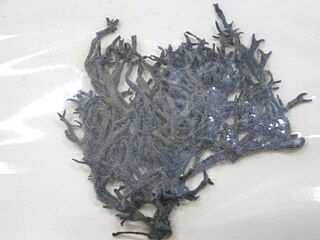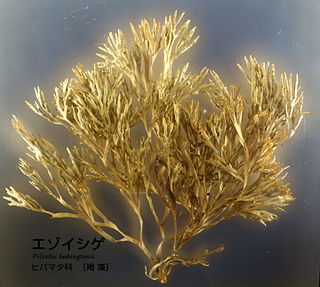
Desmarestiales is an order in the brown algae (Phaeophyceae). Members of this order have terete or ligulate (flat) pinnately branched thalli attached by discoid holdfasts. They have a sporphytic thallus usually aggregated to form a pseudo-parenchyma. The order gets its name from the genus Desmarestia, which is named after the French zoologist Anselme Gaëtan Desmarest (1784–1838).

Dictyotales is a large order in the brown algae. Members of this order generally prefer warmer waters than other brown algae. One genus in this order is calcareous, Padina, the only calcareous member of this phylum.
In botany, a zoid or zoïd is a reproductive cell that possesses one or more flagella, and is capable of independent movement. Zoid can refer to either an asexually reproductive spore or a sexually reproductive gamete. In sexually reproductive gametes, zoids can be either male or female depending on the species. For example, some brown alga (Phaeophyceae) reproduce by producing multi-flagellated male and female gametes that recombine to form the diploid sporangia. Zoids are primarily found in some protists, diatoms, green alga, brown alga, non-vascular plants, and a few vascular plants. The most common classification group that produces zoids is the heterokonts or stramenopiles. These include green alga, brown alga, oomycetes, and some protists. The term is generally not used to describe motile, flagellated sperm found in animals. Zoid is also commonly confused for zooid which is a single organism that is part of a colonial animal.

Durvillaea is a genus of brown algae in the monotypic family Durvillaeaceae. All members of the genus are found in the southern hemisphere, including Australia, New Zealand, South America, and various subantarctic islands.

Alaria is a genus of brown alga (Phaeophyceae) comprising approximately 17 species. Members of the genus are dried and eaten as a food in Western Europe, China, Korea, Japan, and South America. Distribution of the genus is a marker for climate change, as it relates to oceanic temperatures.

Durvillaea antarctica, also known as cochayuyo and rimurapa, is a large, robust species of southern bull kelp found on the coasts of Chile, southern New Zealand, and Macquarie Island. D. antarctica, an alga, does not have air bladders, but floats due to a unique honeycomb structure within the alga's blades, which also helps the kelp avoid being damaged by the strong waves.
Syringodermataceae is a family of brown algae. It includes two genera, Microzonia and Syringoderma.
Nemoderma is the only genus in the family Nemodermataceae and order Nemodermatales of the brown algae. The genus contains only a single species, Nemoderma tingitanum.

Ishige is a genus of brown algae occurring in the warm temperate regions of the western Pacific Ocean. It is the only genus in the family Ishigeaceae.

Ishigeales is an order of brown algae. It includes two families, Ishigeaceae and Petrodermataceae. The genus Diplura is also included, but not placed to family.
Scytothamnales is an order of brown algae.

Sphacelariales is an order of brown algae.

Choristocarpaceae is a family in the order Discosporangiales of the brown algae. The family contains a single genus, Choristocarpus.

Ralfsiales is an order of crustose brown algae containing two families.

Dictyotaceae is large family of brown algae. Members of this order generally prefer warmer waters than other brown algae. One genus in this order is calcareous, Padina, the only calcareous member of this class. Lobophora variegata often presents a beautiful blue iridescence due to microscopic bacteria which live on the surface of the blades. A number of genera are known as forkweed (e.g. Dictyota, Glosophora, Dilophus, Dictyopteris, Pachydictyon and Lobospira.

Himanthalia is a genus of brown algae. It is the only genus in the family Himanthaliaceae in the order Fucales. It includes two species: Himanthalia durvillei and Himanthalia elongata.

Silvetia is a genus of brown algae, commonly known as rockweed, found in the intertidal zone of rocky seashores of the Pacific Ocean. These were originally classified as members of the genus Pelvetia. In 1999, Silvetia sp. was created as a separate species from Pelvetia canaliculata due to differences of oogonium structure and of nucleic acid sequences of the rDNA. It was renamed in honor of Paul Silva, Curator of Algae at the Herbarium of the University of California, Berkeley. There are three species and one subspecies.

Durvillaea fenestrata is a large, robust species of southern bull kelp endemic to the subantarctic Antipodes Islands of New Zealand.

Durvillaea chathamensis is a large, robust species of southern bull kelp endemic to the Chatham Islands of New Zealand.












